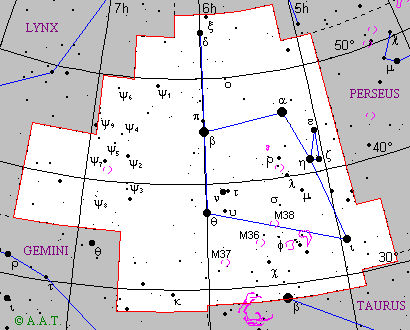 |
 |
| English name | Charioteer | ||||
|---|---|---|---|---|---|
| Major stars | alpha Aurigae | Capella | magn. 0,1 | RA: 05h 16m 41.34s | Dec: +45° 59' 53.9" |
| beta Aurigae | Menkalinan | magn. 2,1 | RA: 05h 59m 31.74s | Dec: +44° 56' 50.7" | |
| epsilon Aurigae | magn. 3,4 | RA: 05h 01m 58.14s | Dec: +43° 49' 23.7" | ||
| eta Aurigae | magn. 3,3 | RA: 05h 06m 30.87s | Dec: +41° 14' 04.3" | ||
| theta Aurigae | magn. 2,7 | RA: 05h 59m 43.29s | Dec: +37° 12' 44.8" | ||
| iota Aurigae | magn. 2,9 | RA: 04h 56m 59.61s | Dec: +33° 09' 57.9" | ||
| Description | Placed to the north of Gemini and Taurus, and situated between Lynx and Perseus, the constellation of Auriga contains the sixth star in order of brightness of the whole vault of heaven: it is Capella, a yellow giant, with a bright issue equal to sixty times that of the Sun. It is the most northern among the stars of first magnitude. Other interesting stars are two eclipse binaries, both situated near the border with the constellation of Perseus: epsilon Aurigae, that has a 27-year period (the longest among the known eclipse binaries), and zeta Aurigae, which every 2 years and 6 months pass during six weeks from the magnitude 3,7 to the magnitude 4,0.
|
||||
| Mythology and history | Many versions exist on the character represented by this constellation. The first one thinks that it is Erittonius, mythical king of Athens, favourite of the goddess Athena. Among the other things, Athena taught to Erittonius the art to tame the horses: he was the first man able to attach four horses to a cart, to imitation of the Sun cart. This brought him the admiration of Zeus, who gave him a place among the stars. Another version, told by Germanicus, identifies Auriga with Mirtilus, the coachman of Enomao king of Elide. Enomao had a very beautiful daughter, Hyppodamia, but whoever wanted to marry her had to beat him in a cart run, of which one could came out or bridegrooms if winner or condemned to death if defeated. Quite a lot of aspirants were already killed, when came Pelopious, who corrupted the coachman Mirtilus, who let him win by tampering with Enomao's cart. After the victory, considering that also Mirtilus was fallen in love with Hyppodamia, Pelopius killed him throwing him in the sea. A third hypothesis says that Auriga is the son of Theseus, Hyppolitus, with whom the stepmother Fedra was lostly fallen in love. Hyppolitus, who was interested only in hunt and horses, rejected her and she, for desperation, committed suicide leaving a writing in which she falsely denounced the youth to have done her violence. Theseus then sent his son away, who a little afterwards, while he was getting further on his cart, had an accident and died. In the sky Auriga is drawn with a goat in arm, represented by the star Capella (that exactly means "little goat", in Latin). |
||||
 Back to constellations page.
Back to constellations page.